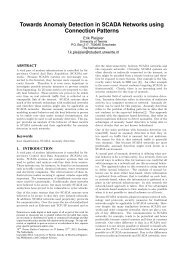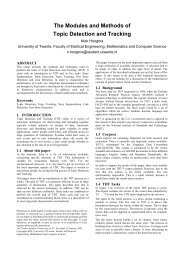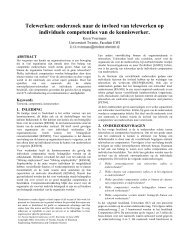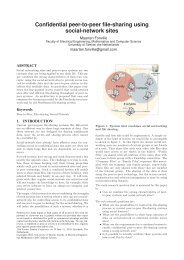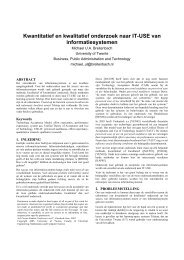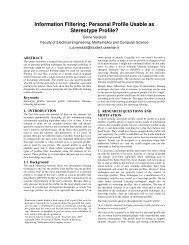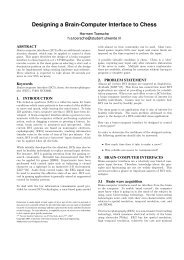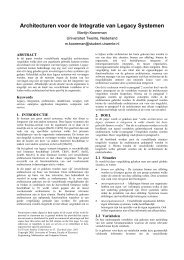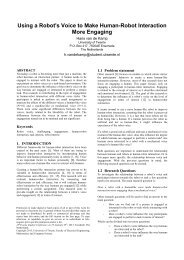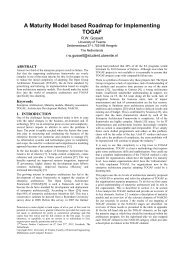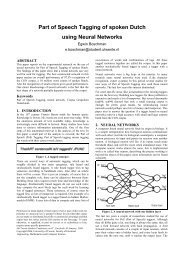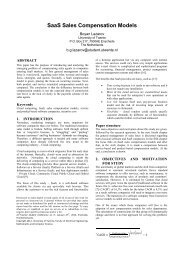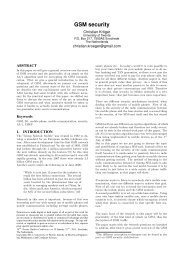Proceedings Template - WORD - Twente Student Conference on IT
Proceedings Template - WORD - Twente Student Conference on IT
Proceedings Template - WORD - Twente Student Conference on IT
Create successful ePaper yourself
Turn your PDF publications into a flip-book with our unique Google optimized e-Paper software.
3.1 Simulati<strong>on</strong> Envir<strong>on</strong>ment<br />
The simulati<strong>on</strong>s are executed in OMNeT++ [14] in combinati<strong>on</strong><br />
with MiXiM [13]. OMNeT++ is an open source discrete event<br />
simulati<strong>on</strong> envir<strong>on</strong>ment which can be used for modelling<br />
wireless communicati<strong>on</strong> networks [14]. MiXiM is used as an<br />
expansi<strong>on</strong> for OMNeT++ to implement a wireless and mobile<br />
network, like a VANET. With OMNeT++ and the MiXiM<br />
framework the IEEE 802.11p and the IEEE 1609.4 multichannel<br />
operati<strong>on</strong>s are implemented.<br />
In the simulati<strong>on</strong>s it is assumed that all the nodes are within<br />
each other’s range and their positi<strong>on</strong> does not change. All nodes<br />
are visible to each other so in this situati<strong>on</strong> no hidden terminals<br />
exist.<br />
The nodes are uniformly distributed in an area smaller than the<br />
communicati<strong>on</strong> range. Due to the simplified propagati<strong>on</strong> model,<br />
relative positi<strong>on</strong> and distances between nodes have no impact.<br />
Also it is assumed that the communicati<strong>on</strong> channel (CCH) is a<br />
‘perfect channel’, so no bit errors can occur during<br />
transmissi<strong>on</strong>. This means that packets can <strong>on</strong>ly be lost during a<br />
collisi<strong>on</strong>. This is not how VANETs will operate in the real<br />
world, but it gives insight <strong>on</strong> the beac<strong>on</strong>ing performance when<br />
different buffering/queuing-mechanisms and different channel<br />
switching methods are used.<br />
3.1.1 Simulati<strong>on</strong> scenarios/modes<br />
Two main simulati<strong>on</strong> scenarios/modes are used and analysed in<br />
the simulati<strong>on</strong> experiments.<br />
The scenario that implements the operati<strong>on</strong> of the CCH as<br />
defined in IEEE 802.11p, where a transmitting node uses 100%<br />
of the time the CCH for beac<strong>on</strong>ing is denoted as c<strong>on</strong>tinuous<br />
scenario.<br />
The scenario wherein a node switches every 50 millisec<strong>on</strong>ds<br />
between the CCH and the SCH, as specified in IEEE 1609.4 is<br />
denoted as alternating scenario.<br />
3.1.2 Simulati<strong>on</strong> parameters<br />
The simulati<strong>on</strong> experiments are performed using the following<br />
parameters:<br />
- Beac<strong>on</strong> generati<strong>on</strong> rate: For safety messages it is assumed<br />
that 10 messages per sec<strong>on</strong>d are sufficient to provide a<br />
cooperative awareness [5]. The mean beac<strong>on</strong> generati<strong>on</strong> rate is<br />
10 Hz. In the c<strong>on</strong>tinuous scenario the generati<strong>on</strong> of beac<strong>on</strong>s is<br />
uniformly distributed. In the alternating scenario beac<strong>on</strong><br />
generati<strong>on</strong> is restricted to a uniform distributi<strong>on</strong> within the CCH<br />
guard and CCH periods, minus the durati<strong>on</strong> of <strong>on</strong>e<br />
transmissi<strong>on</strong>. This method is similar to the <strong>on</strong>e used in [2], see<br />
Eq. 1.<br />
Unif(0, T cch – T s ) (1)<br />
Where, T cch stands for the CCH interval time, namely 50 ms.<br />
and T s for the durati<strong>on</strong> of the transmissi<strong>on</strong> of <strong>on</strong>e beac<strong>on</strong>, see<br />
[2].<br />
- Data rate: In the simulati<strong>on</strong>s a data rate of 3 Mbit/s is used for<br />
all nodes, the lowest data rate defined in IEEE 802.11p. Given<br />
the critical nature of the communicated informati<strong>on</strong>, the most<br />
robust modulati<strong>on</strong> is assumed.<br />
- EDCA class: EDCA class 0 (Background traffic, see Table 1)<br />
is used in the simulati<strong>on</strong>s. The EDCA 0 class has the largest<br />
c<strong>on</strong>tenti<strong>on</strong> window CW min, namely 15, see Table 2. This gives<br />
transmitted beac<strong>on</strong>s the smallest probability of collisi<strong>on</strong>s due to<br />
simultaneous expirati<strong>on</strong> of backoff counters, see [15].<br />
- Beac<strong>on</strong> size: As stated earlier, a typical beac<strong>on</strong> has a size of<br />
400 bytes, including security fields. This beac<strong>on</strong> size is<br />
therefore used in the simulati<strong>on</strong>s.<br />
- Scheduling: There exists two popular scheduling mechanisms,<br />
namely First-In, First-out (FiFo) and Last-in, Last-out (LiFo). In<br />
a FiFo scheduler packets are transmitted in the order as they<br />
arrived. On the c<strong>on</strong>trary, with a LiFo scheduler newly arrived<br />
packets are transmitted first. From [6] it can be c<strong>on</strong>cluded that it<br />
does not really make any difference which of the two<br />
menti<strong>on</strong>ed scheduling mechanisms (LiFo or FiFo) is used. For<br />
this reas<strong>on</strong> a FiFo scheduler is used in the simulati<strong>on</strong>s as this is<br />
also the standard scheduling mechanism used in EDCA.<br />
- Number of nodes: The simulati<strong>on</strong>s are performed using a<br />
different number of nodes to simulate different vehicle<br />
densities. The number of nodes ranges from 10 to 120 nodes,<br />
where 120 nodes is a realistic number of nodes during rush hour<br />
<strong>on</strong> a highway, within transmissi<strong>on</strong> range Note that for the<br />
c<strong>on</strong>tinuous scenario 160 and 200 nodes were also c<strong>on</strong>sidered.<br />
- Queue size: The simulati<strong>on</strong>s are performed with different<br />
queue sizes to analyse the buffering performance. The maximal<br />
queue size ranges from 1 to 5 packets.<br />
- Buffering mechanism: To analyse which buffering mechanism<br />
perform best two buffer mechanisms are compared, namely<br />
Oldest Packet Drop (OPD) and Newest Packet Drop (NPD), see<br />
[6]. With OPD the oldest packet in the queue is dropped when<br />
the queue is full in order to make room for a newly arrived<br />
packet. With NPD however, the newly arriving packet is<br />
dropped if it finds the queue full. This is the default tail-drop<br />
policy adopted in many implementati<strong>on</strong>s.<br />
- Propagati<strong>on</strong> model: The freshness of a received beac<strong>on</strong><br />
depends <strong>on</strong> several comp<strong>on</strong>ents, such as queuing delay,<br />
c<strong>on</strong>tenti<strong>on</strong> delay and transmissi<strong>on</strong> delay. In these experiments<br />
all generated beac<strong>on</strong>s have the same length, so the transmissi<strong>on</strong><br />
delay becomes a c<strong>on</strong>stant. Because of the fact that all nodes in a<br />
VANET are relative close to each other, the propagati<strong>on</strong> delay<br />
is negligible.<br />
Parameters not listed in Table 2 or 3 can be found in the IEEE<br />
802.11p [11] or IEEE 1609.4 [10] specificati<strong>on</strong>s.<br />
Parameter<br />
Beac<strong>on</strong> generati<strong>on</strong> rate<br />
Data rate<br />
EDCA class<br />
Beac<strong>on</strong> size<br />
CW min<br />
Scheduling<br />
Simulated time limit<br />
Parameter<br />
Number of nodes<br />
Queue size<br />
Buffering<br />
Mode<br />
Table 2: Simulati<strong>on</strong> parameters<br />
Value<br />
10 Hz<br />
3 Mbit/s<br />
AC0<br />
400 bytes<br />
15<br />
FIFO<br />
200 sec<strong>on</strong>ds<br />
Table 3: Varied parameters<br />
Value<br />
[10, 20, 30, 40, 60, 80, 120,<br />
160, 200 (Only for<br />
C<strong>on</strong>tinuous mode)]<br />
[1, 2, 5]<br />
[NPD, OPD]<br />
[C<strong>on</strong>tinuous, alternating]



